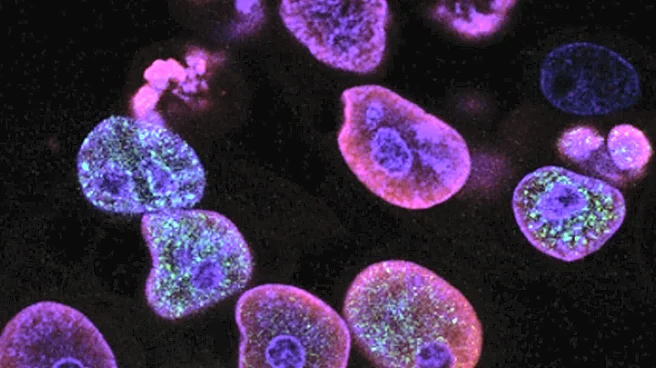What is the story about?
What's Happening?
A study conducted by Duke University School of Medicine has revealed that pancreatic alpha cells, traditionally known for producing glucagon, also generate GLP-1, a hormone that enhances insulin production and regulates glucose levels. This discovery challenges existing beliefs about blood sugar regulation and suggests a new approach to treating type 2 diabetes. The research, led by Jonathan Campbell, PhD, utilized mass spectrometry to demonstrate that human alpha cells produce significantly more bioactive GLP-1 than previously thought. This hormone mimics the effects of popular diabetes medications like Ozempic and Mounjaro. The study involved analyzing pancreatic tissue from mice and humans, showing that GLP-1 production is linked to insulin secretion, offering a potential natural method to support insulin and manage blood sugar levels.
Why It's Important?
The findings from Duke University could have significant implications for diabetes treatment, particularly for type 2 diabetes, where the body's beta cells fail to produce sufficient insulin. By enhancing the body's natural GLP-1 production, this research suggests a more organic method to support insulin secretion and maintain blood sugar balance. This could lead to new therapeutic strategies that leverage the body's own mechanisms, potentially reducing reliance on external medications. The ability of alpha cells to switch from glucagon to GLP-1 production during metabolic stress highlights a natural backup system for blood sugar control, which could be crucial in developing treatments that are less invasive and more aligned with the body's natural processes.
What's Next?
Future research may focus on finding safe methods to boost GLP-1 production from alpha cells, which could naturally enhance insulin secretion in individuals with diabetes. The study opens avenues for exploring how common metabolic stressors, such as high-fat diets, modestly increase GLP-1 production, and how this can be optimized for therapeutic purposes. Additionally, the development of high-specificity mass spectrometry assays to accurately measure bioactive GLP-1 could further refine treatment approaches, ensuring that interventions target the most effective forms of the hormone.
Beyond the Headlines
This discovery not only impacts diabetes treatment but also offers insights into the body's adaptive mechanisms in response to metabolic stress. The ability of alpha cells to produce GLP-1 suggests a more complex interplay between different types of pancreatic cells than previously understood. This could lead to broader implications for understanding metabolic diseases and developing treatments that harness the body's natural regulatory systems. The research also underscores the importance of innovative scientific methods, such as mass spectrometry, in uncovering new biological pathways and potential therapeutic targets.
AI Generated Content
Do you find this article useful?













